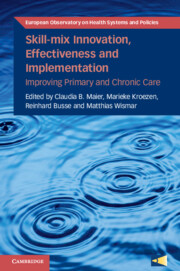Health systems all over the world rely on their health workers, their skills and education, as well as commitment and dedication to improve population health and treat individual patients. Achieving or maintaining universal health coverage is closely linked to a sufficient number of health workers with the right skills and knowledge to perform high-quality care. Yet, the health workforce in many countries across Europe is undergoing rapid changes in the education, scope-of-practice and ways of collaboration in teams.
These changes are exemplified by the COVID-19 pandemic. Health workers were at the frontline to respond quickly to public health emergencies and crises. The COVID-19 pandemic has affected virtually all countries worldwide – albeit to different extents – and has shown the public what contribution doctors, nurses, public health professionals, health care assistants and other health professionals make to treat patients. Across Europe and globally, the flexibility, commitment and motivation of health professionals to treat patients were remarkable. New skills and knowledge had to be acquired in limited time, new teams had to be formed and tasks had to be transferred from one profession to another. Many of these factors had to be implemented in limited time and under constraint contexts. There was limited evidence on what worked and with which outcomes.
The topic of the book on skill-mix innovations in primary care and for patients with chronic conditions could therefore not be more timely. Although it does not cover skill-mix changes during the COVID-19 pandemic – partly because it remains too early to evaluate results – the book addresses what we know from the scientific evidence on skill-mix and outcomes on individuals, population groups and health systems. The book provides an overview on skill-mix models, what additional, new roles (for example, patient navigators, case managers) can mean for patients and their outcomes, which tasks can be shifted to which profession(s) and for which patient groups, and what team configurations and ways of collaboration mean in practice.
The year 2020 was not only instrumental in raising the public’s awareness of the contribution of health workers to patients’ health during the COVID-19 pandemic, but was also timely, as the International Year of Nurses and Midwives. WHO has organized a number of events to celebrate the contribution of nurses and midwives and raise public awareness of these two important professions globally. As the book shows, many of the innovations in skill-mix are related to nurses who are now working in expanded roles in many functions, partly due to substantial changes to their education across Europe over the past decade.
In addition, WHO Regional Office for Europe has established several priorities to strengthen health professionals across the European region. The priorities link closely with the education, skills, teams and work conditions under which health workers work. The priorities are as follows:
Formulate national strategies for modernizing the working conditions and modus operandi of the existing workforce and for aligning the production of the future workforce with the requirements of post-COVID-19 recovery.
Convene a supranational consortium to develop in-service training programmes to reorient and requalify the existing workforce towards people-centred care in the post-COVID-19 context.
Build consensus around regional and subregional policies for a fairer distribution of the health workforce: monitoring of mobility and migration; shared strategies to mitigate push factors (including deskilling, burnout and demotivation); and actions to foster a relationship of trust between health workers and health authorities.Footnote 1
Skill-mix towards people-centred, high-quality health services is instrumental to ensure that health systems continue to be resilient and sustainable. Analysing and evaluating what skill-mix models exist for different population and patient groups, and with which outcome(s), is therefore a first step to understand what might work in what context and for which groups. The book makes an important contribution on this topic, it is the first of its kind to synthesize the evidence in a systematic manner.
Second, implementation is key. This is also addressed by the book. Analysing the policy context – that is, the role that policy, regulation and payment models can have on new professional roles, new tasks and division of work in teams – is critical for practice uptake. This also applies to the health care organization in which health workers work. Strategies are required not only at the policy level, but also by health care managers to strategically plan and implement change management, which takes account of the individual workers needs and concerns. Effective implementation can therefore be a strategic way for countries towards building a flexible, well-performing health workforce with the right skill-sets and competencies to provide timely, high-quality care.
1 WHO Europe: European Programme of Work; https://apps.who.int/iris/bitstream/handle/10665/333908/70wd11e-rev4-EPW-200673.pdf?sequence=1&isAllowed=y

